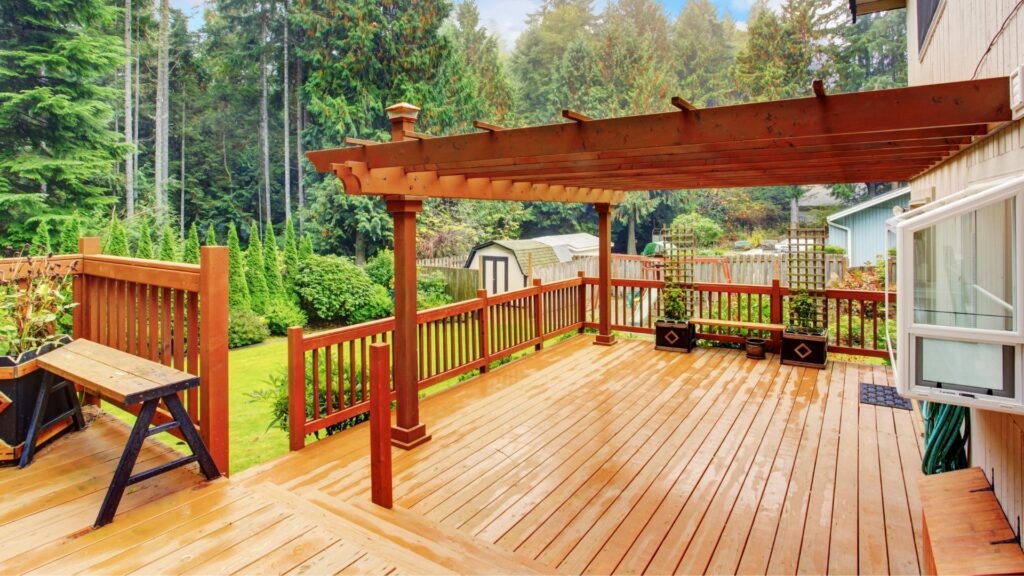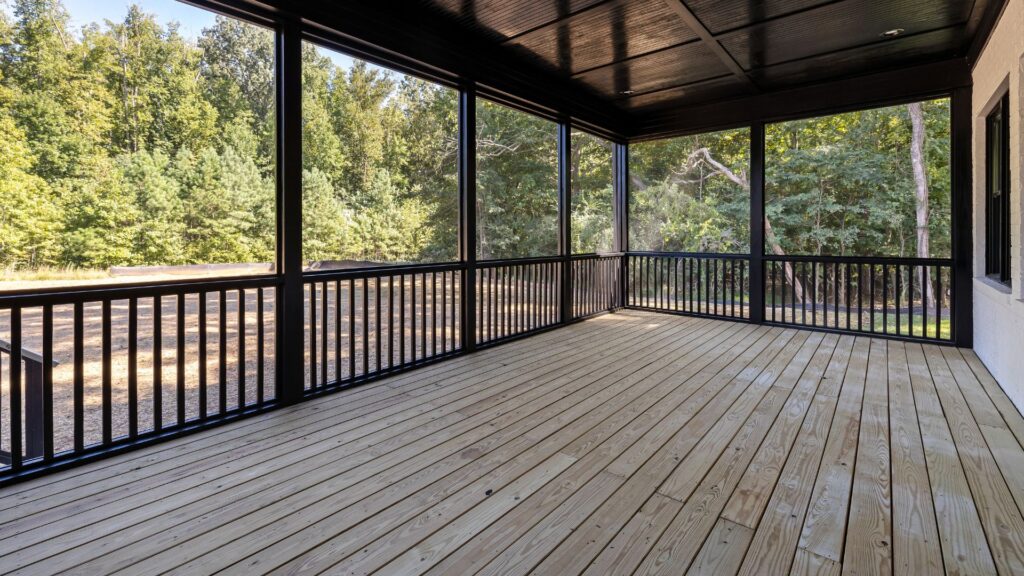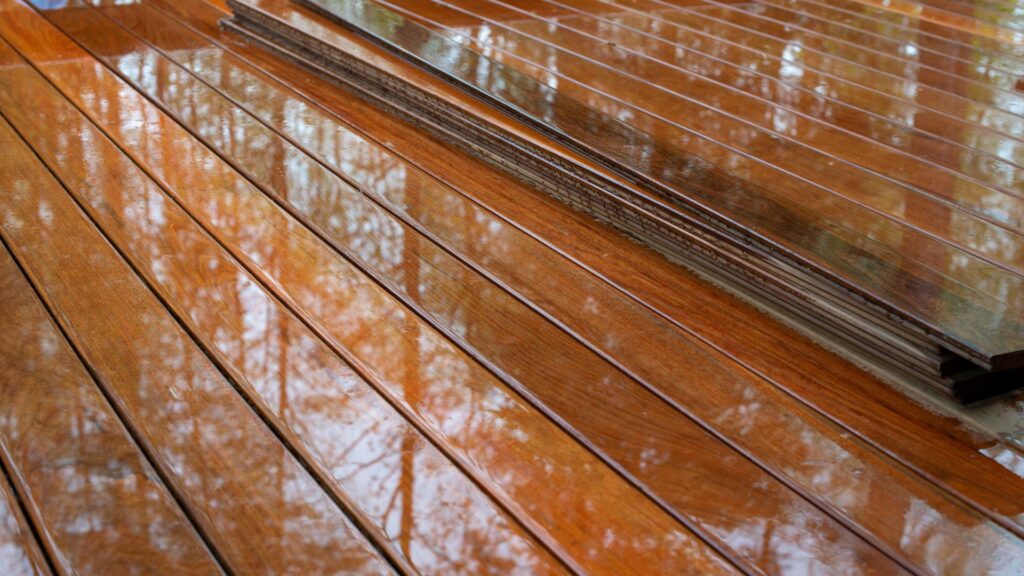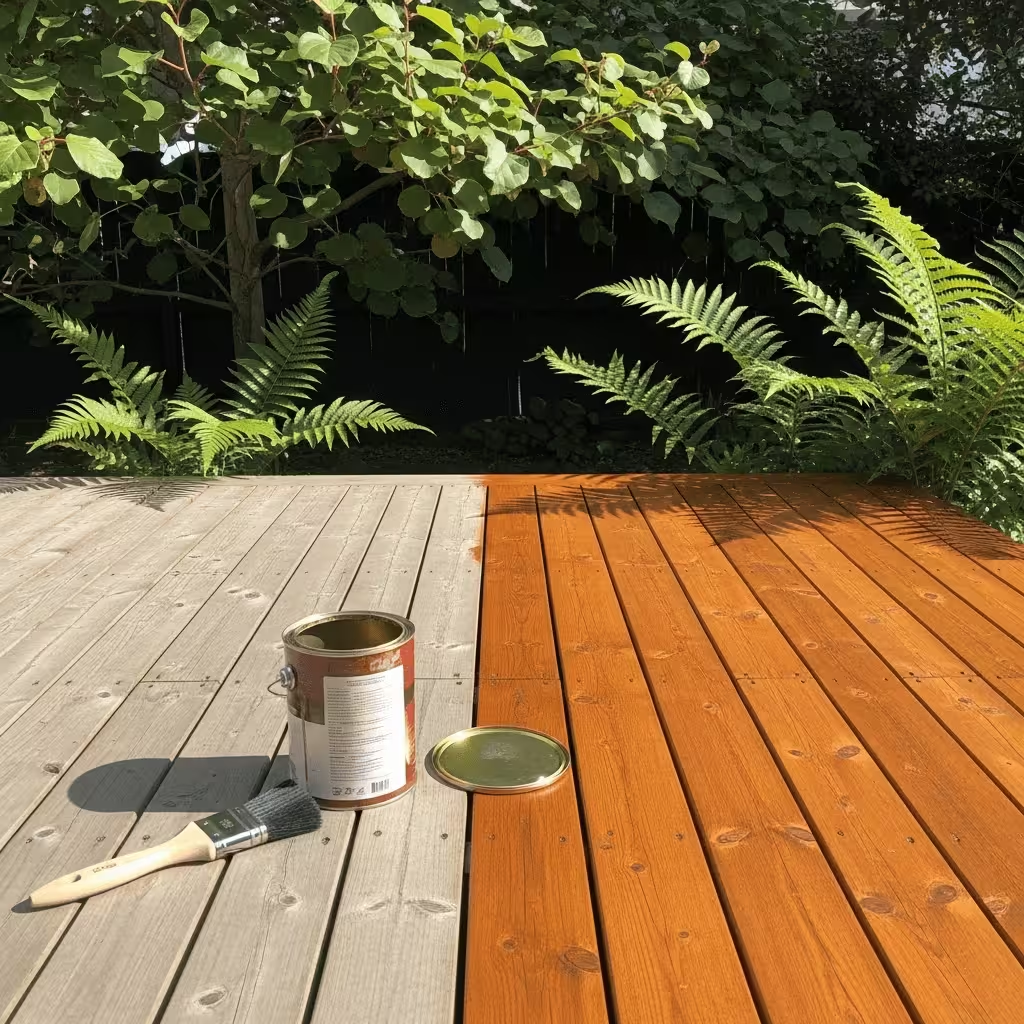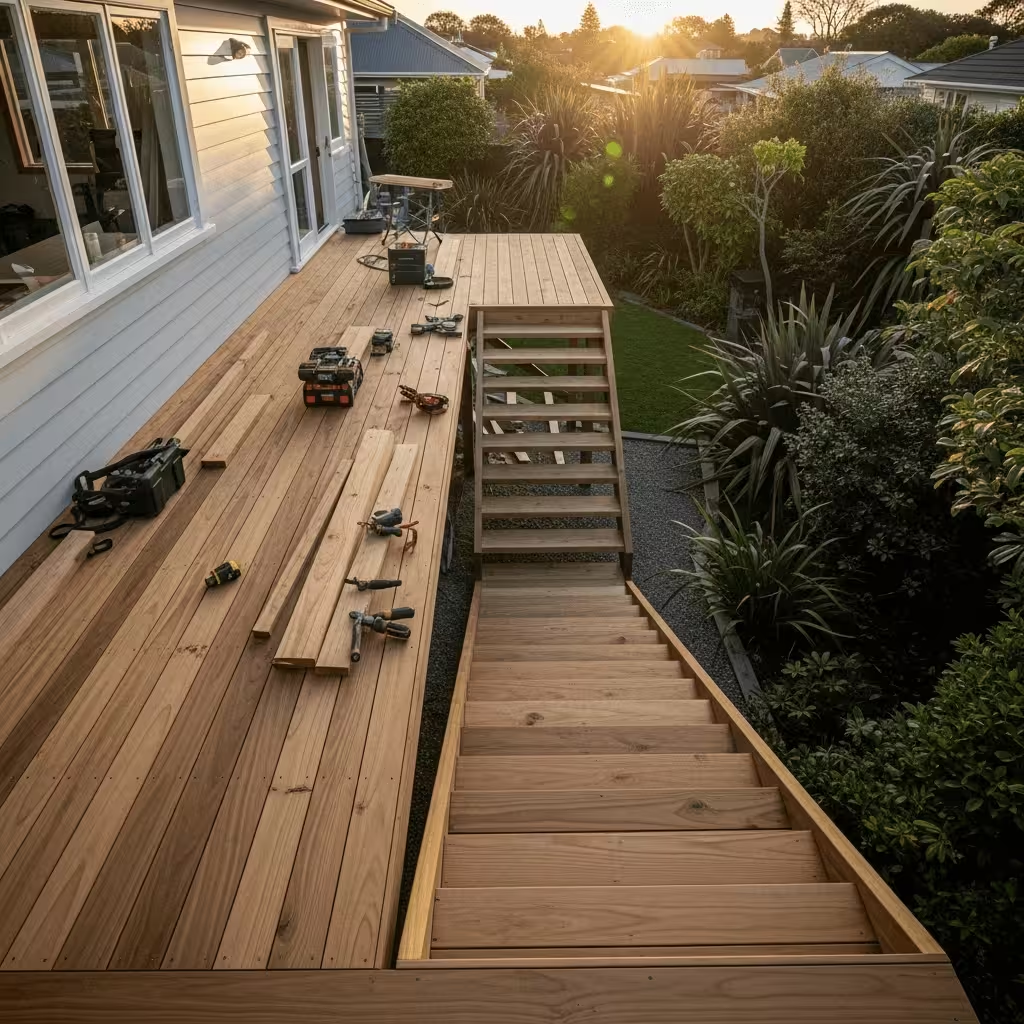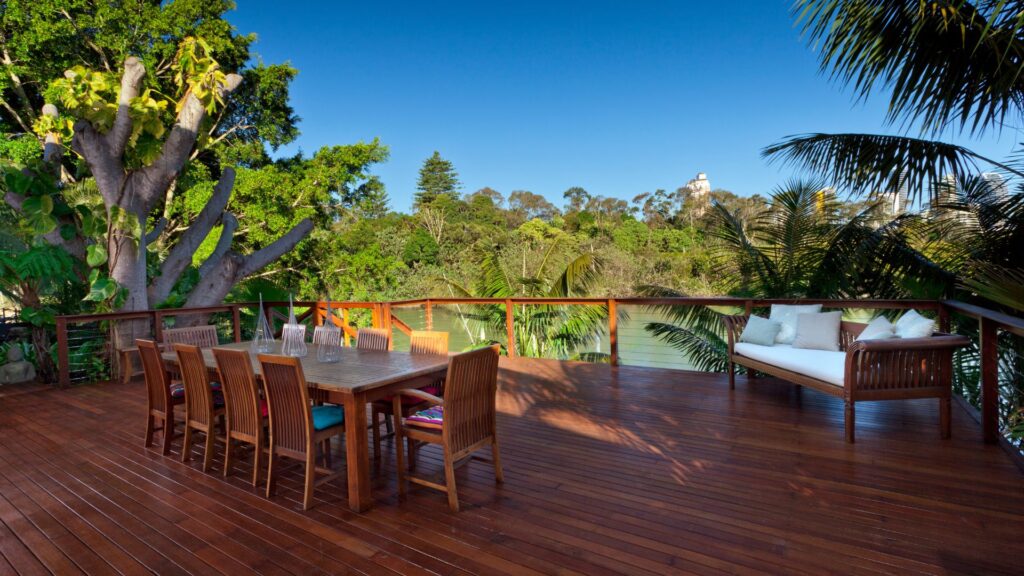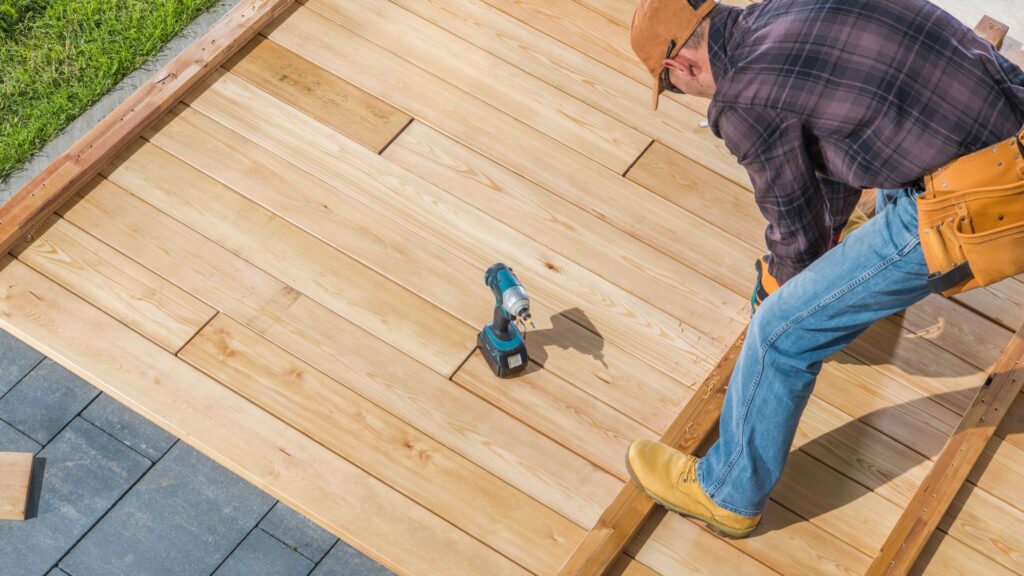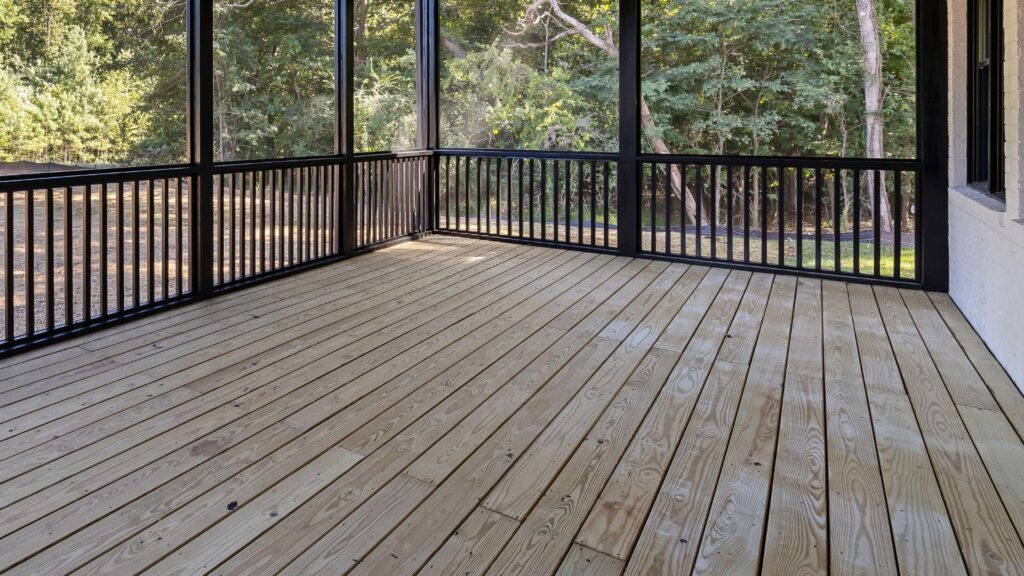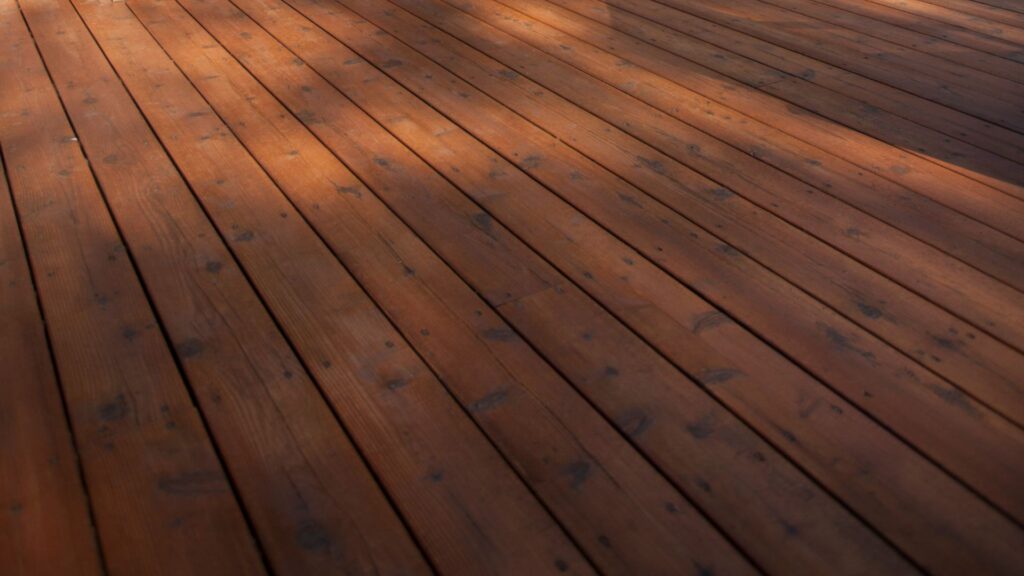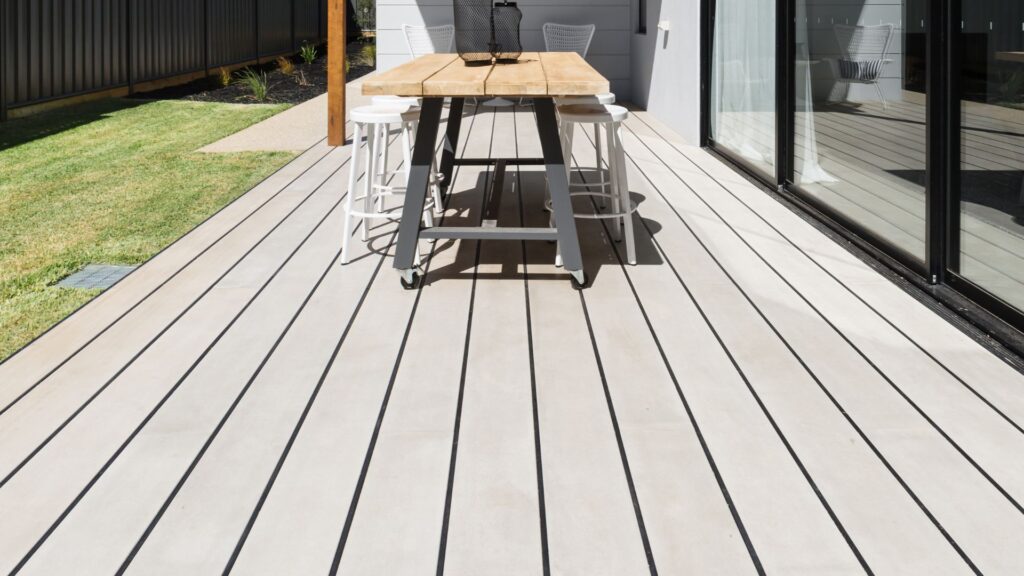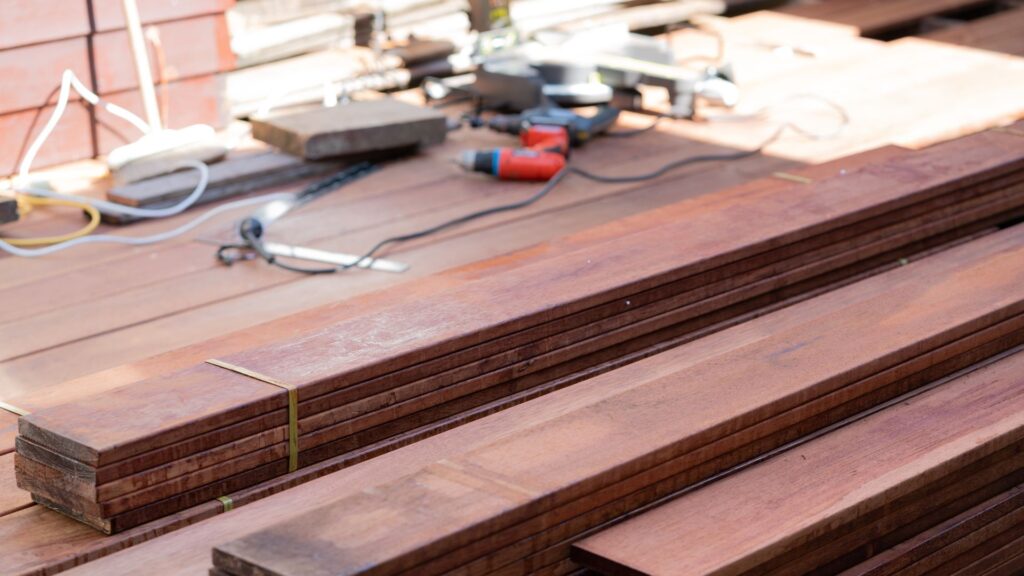Welcome to your guide on understanding the cost of decking in NZ, where we’ll break down everything you need to know before starting your project. Decks are a staple in Kiwi homes, adding value and creating a space to enjoy the outdoors, but knowing what it will actually cost can feel confusing. Prices vary widely depending on the materials you choose, the size and style of the deck, labour rates in your area, and extra features like railings or built-in seating. In this article, we’ll cover the average costs, the factors that drive prices up or down, the pros and cons of different materials, and tips to budget wisely so you get the best value for your money. Whether you’re planning a simple timber deck or considering premium composite options, this guide will help you make an informed decision and avoid unexpected surprises.
The cost of decking in NZ ranges from $250 to $600+ per square metre, depending on the material, size, design, and labour. Pine decking is the most affordable option, while hardwoods and composite materials sit at the higher end. Extra costs may include site preparation, council consents, and ongoing maintenance. Always compare quotes and consider long-term value when planning your deck.
Table of Contents
What Is The Average Cost Of Decking In NZ?
Most Kiwi homeowners pay about $300–$700 per square metre for a new deck, with budget pine builds toward the lower end and hardwood or composite projects toward the higher end. These figures reflect typical installed prices in New Zealand and vary by material, site, and scope.
Broad Price Range You Can Use Today
- Entry range: $300–$450 per m² for simple, small pine decks on flat sites.
- Mid range: $450–$650 per m² for larger pine or entry-level composite builds.
- Premium range: $650–$900+ per m² for hardwood or higher-end composite, and designs with stairs or balustrades.
Quick Snapshot Of Low-End Vs High-End Costs
- Low end example: 20 m² pine deck at $350–$450 per m² ≈ $7,000–$9,000 installed.
- High end example: 20 m² hardwood or composite at $650–$900 per m² ≈ $13,000–$18,000+.
Why Prices Move Up Or Down
- Materials: Pine is cheapest; hardwoods like kwila and most composites cost more. Composite supply and brand can shift per-m² pricing; hardwoods often start around $650+ installed.
- Size and design: Bigger decks, multi-levels, curves, picture-frame borders, or complex layouts add time and materials, lifting the per-m² rate.
- Labour and location: Labour commonly sits around $60–$100 per hour, with higher rates in major centres. Complex builds or tight access add hours.
- Site conditions and extras: Sloped sites, deep posts, retaining, stairs, handrails, and lighting push totals higher. Factor consent needs for height; decks that allow a fall over 1.5 m generally require consent.
How To Get A Reliable Number
- Ask for itemised quotes that split materials, labour, and extras.
- Share site photos and measurements to reduce guesswork.
- Confirm whether prices include GST, waste removal, and finishing oils or stains.
- Check if consent or engineering applies before you lock a start date.
Use these figures as a planning anchor, then firm them up with two to three local quotes that reflect your material choice, site, and design.
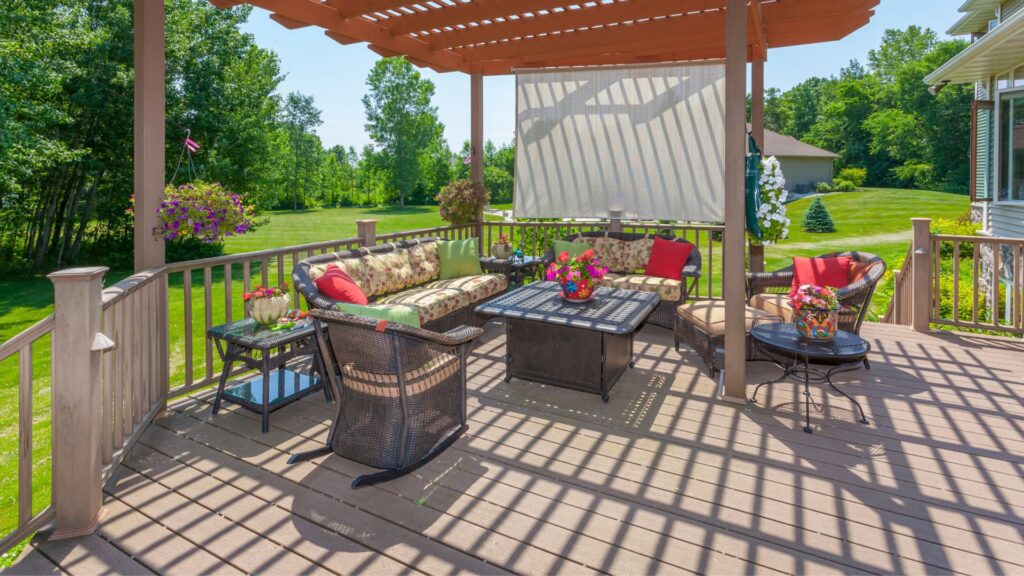
Factors That Affect Decking Costs
Building a deck in New Zealand comes with many variables that influence the final price. While most homeowners start by asking, “What is the average cost of decking in NZ?”, the answer depends on more than just square metres. Below are the most important factors that determine how much you’ll pay for your deck.
Material Choice
The type of material you choose has the biggest impact on the overall cost of your deck.
- Timber (Pine): The most affordable option, pine is widely available and easy to work with. It’s a budget-friendly choice, though it does require ongoing maintenance like staining or oiling to stay in good condition.
- Hardwoods (Kwila, Vitex, Garapa): These materials are more expensive than pine but are highly durable and long-lasting. Kwila, for example, offers a rich, deep colour and excellent strength, making it a popular choice for premium decks.
- Composite Decking: Made from a blend of wood fibres and recycled plastics, composites are priced higher than pine but are low-maintenance. They resist fading, rotting, and warping, which saves on upkeep costs in the long run.
- PVC Decking: This is the most durable option, completely resistant to moisture and pests. It comes with a higher price tag but is a smart investment for homeowners who want a long-lasting deck with virtually no maintenance.
Deck Size And Design
The size and design of your deck will directly influence labour hours, material use, and overall costs.
- Simple Rectangle Designs: These are the cheapest to build, as they require less cutting and labour time.
- Multi-Level Decks: More complex layouts with multiple levels or custom shapes significantly increase both material and labour costs.
- Add-On Features: Built-in seating, planters, or pergolas add to the cost, but they also create a more functional and appealing outdoor space.
Labour And Region
Labour is a major cost driver, and rates vary across New Zealand.
- Auckland And Major Cities: Labour costs are higher due to increased demand and higher living expenses. Builders in these areas often charge more per hour, so decking projects in Auckland, Wellington, or Christchurch can cost noticeably more than in smaller towns.
- Regional NZ: In rural areas, labour rates tend to be lower, but access to specialised materials may be limited, which can add to transport costs.
- Skill Level: Hiring experienced builders usually costs more upfront, but their expertise ensures quality workmanship that saves you money in the long term.
Site Conditions
The condition of your property plays a key role in determining decking costs.
- Flat And Accessible Sites: These are the easiest and cheapest to build on. Builders can work faster, and material handling is simpler.
- Sloped Or Uneven Land: Building on a slope often requires extra foundation work, retaining walls, or reinforced framing, which raises costs.
- Difficult Access: If your backyard has limited access for tools, machinery, or materials, labour times can increase, pushing the overall price higher.
Extra Features
Adding features to your deck can enhance its usability and appeal, but they also add to the budget.
- Railings And Balustrades: Essential for safety on elevated decks, these increase material and labour costs. The style you choose, glass, timber, or metal, affects the final price.
- Stairs: Multi-level decks or decks built above ground level require stairs, which add complexity and expense.
- Lighting: Built-in LED lighting or solar lights can make your deck more functional at night, but these extras raise the installation cost.
- Built-In Seating And Storage: These features add comfort and convenience, but they come at an additional cost compared to a simple flat deck.
Every decking project in NZ is unique, and understanding these factors will help you plan a budget that fits your lifestyle and property. From choosing between pine or composite boards to accounting for hidden labour differences between Auckland and smaller towns, these cost drivers highlight why it’s important to get multiple quotes and think long-term. The right balance between material choice, design, and features will ensure your deck is both affordable and enjoyable for years to come.
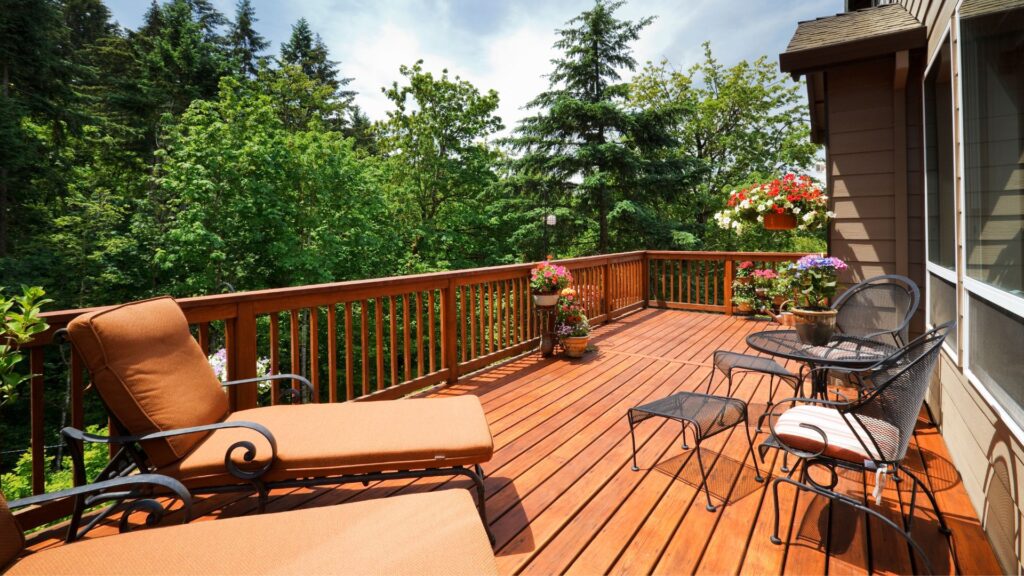
Cost Breakdown By Decking Material
When planning a new deck in New Zealand, one of the biggest decisions you’ll face is which material to choose. The material affects not only the cost but also the look, durability, and maintenance required over time. Below is a clear breakdown of the most common decking options in NZ, their approximate costs per square metre, and the pros and cons of each.
Pine Decking
Pine is the most budget-friendly decking option in New Zealand, with prices starting from around $250–$350 per m². It is easy to source locally and widely used by homeowners who want an affordable outdoor space.
Pros
- Low upfront cost compared to other materials.
- Easy to work with for DIY projects.
- Readily available throughout NZ.
Cons
- Requires regular maintenance such as staining or oiling.
- Shorter lifespan than hardwoods or composite.
- More prone to warping and weathering over time.
Pine decking is a great choice if you’re working with a limited budget, but you must be prepared for consistent upkeep.
Kwila And Hardwoods
Kwila and other hardwoods such as Vitex or Garapa are considered premium decking choices. Prices typically range from $350–$550 per m² depending on the timber and supply. These timbers offer a rich, natural look that many Kiwis love.
Pros
- Strong and durable, lasting decades with proper care.
- Attractive, high-end appearance.
- Naturally resistant to pests and decay.
Cons
- Higher upfront cost.
- Can heat up in direct sun, making them less comfortable underfoot.
- Requires oiling to maintain colour and protect against weathering.
If you’re looking for a long-lasting deck with timeless appeal, hardwoods are an excellent investment.
Composite Decking
Composite decking is made from a mix of wood fibres and recycled plastics. In NZ, prices usually fall between $400–$600 per m². This option has become increasingly popular because it offers a balance between durability and minimal maintenance.
Pros
- Extremely low maintenance, no staining or painting needed.
- Resistant to warping, rot, and insect damage.
- Available in a wide range of colours and finishes.
- Eco-friendly, often made with recycled materials.
Cons
- More expensive than pine.
- Can look less natural than real wood.
- Needs professional installation for best results.
Composite decking is perfect for homeowners who want a stylish, hassle-free deck that stands the test of time.
PVC/Plastic Options
PVC or fully plastic decking is less common in New Zealand but offers excellent durability. It usually sits at the top end of the market, with costs ranging from $500–$650 per m².
Pros
- Extremely durable and long-lasting.
- Very low maintenance, only requires occasional cleaning.
- Resistant to fading, moisture, and pests.
Cons
- Higher upfront price compared to other materials.
- Less natural appearance than timber.
- Limited availability in some regions.
PVC is best for homeowners who value durability and convenience over the traditional look of timber.
Choosing The Right Material For Your Deck
When weighing up options, think about your budget, how much time you’re willing to spend on maintenance, and the style you want for your outdoor space. Pine is cost-effective but needs upkeep, hardwoods provide beauty and strength at a higher cost, composites give a modern low-maintenance solution, and PVC offers top-tier durability for those willing to spend more upfront.
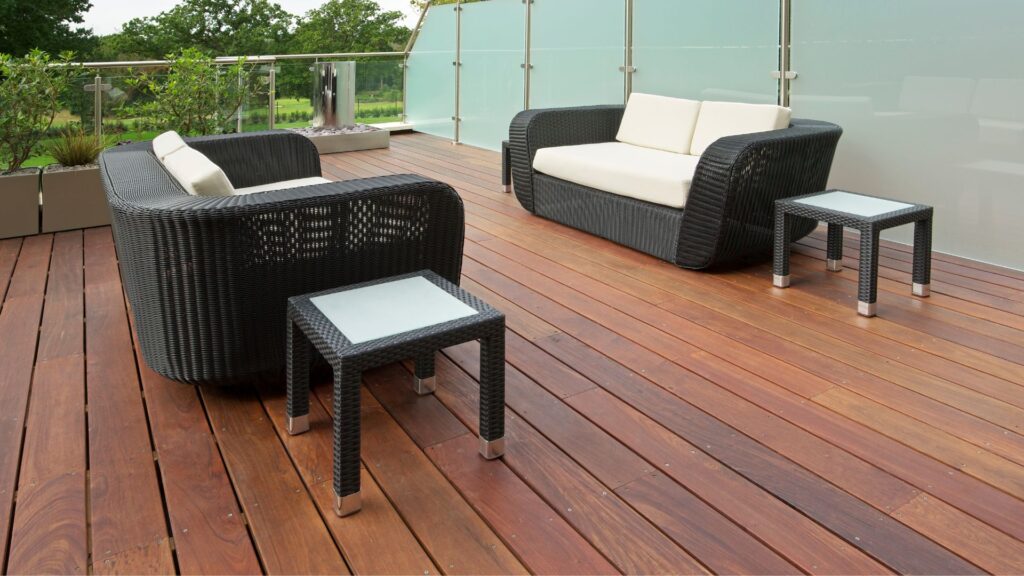
Hidden Or Overlooked Costs
When planning the cost of decking in NZ, most homeowners focus on the price of materials and labour. But there are often extra expenses that can catch you off guard. Factoring in these hidden or overlooked costs early on will save you from budget blowouts later.
Building Consent Fees
In New Zealand, you may need building consent for your deck, especially if it is higher than 1.5 metres above ground level. These fees vary by region but can add several hundred dollars to your overall project cost. Many homeowners forget to include this step, only to face unexpected delays and expenses when construction is already underway. Always check with your local council before starting to avoid surprises.
Ground Preparation, Foundations, And Retaining Walls
The state of your backyard plays a big role in the final price of your deck. If your site is flat and easy to access, preparation costs will be minimal. But if you’re building on a slope, need soil removal, or require retaining walls, expect to pay more. Solid foundations are essential for safety and durability, so cutting corners here could lead to long-term problems. It’s worth getting a professional assessment of your site before you start building.
Fasteners, Fixings, And Treatments
Nails, screws, brackets, and protective treatments might seem like minor expenses, but they add up quickly. High-quality fasteners and fixings ensure your deck is strong and safe, especially in New Zealand’s changing weather conditions. If you’re using timber, treatments to prevent rot and insect damage are also necessary. These costs are often left out of initial quotes but are vital for a deck that will last.
Ongoing Maintenance: Staining, Oiling, And Repairs
The cost of a deck doesn’t stop once it’s built. Timber decks, in particular, require regular maintenance to stay looking good and structurally sound. Staining or oiling should be done every one to two years, depending on the climate and exposure to the elements. This can cost a few hundred dollars each time. Over the years, you may also need to replace boards, fix loose nails, or carry out small repairs. While composite decking requires far less upkeep, even it will need occasional cleaning and checks.
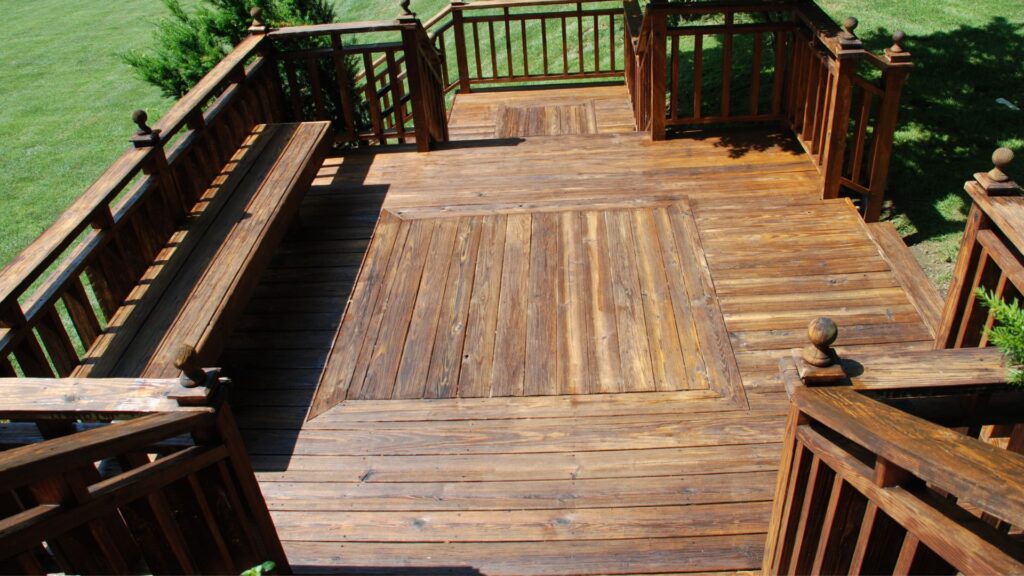
DIY Vs Hiring A Professional
Building a deck is one of the most rewarding home improvement projects, but the big decision many homeowners face is whether to tackle it themselves or bring in a professional builder. Both options have benefits and drawbacks, and the right choice depends on your skills, budget, and expectations for the finished result.
DIY Decking: Savings But Risks In Quality, Time, And Tools
Choosing the DIY route can save a significant amount on labour costs, which often make up a large portion of the total decking price in New Zealand. If you’re confident with power tools, enjoy hands-on projects, and have the time to dedicate, DIY decking may feel like a great option. But there are challenges to consider:
- You’ll need the right tools and safety gear.
- Mistakes in measurements or installation can be costly to fix.
- Council consent and building code compliance still apply.
- DIY projects often take much longer than expected.
For smaller, ground-level decks, a skilled DIYer might manage well. But for raised or complex decks, the risk of structural issues increases, which can compromise safety and durability.
Hiring A Builder: Higher Upfront Cost But Expertise And Peace Of Mind
Hiring a professional deck builder comes with a higher upfront investment, but it delivers long-term benefits. Builders have the knowledge to design and construct decks that meet New Zealand building standards, ensuring your project is both safe and durable. Key advantages include:
- Professional finish with attention to detail.
- Compliance with local council regulations and building codes.
- Access to warranties or guarantees on workmanship.
- Efficiency projects are usually completed much faster than DIY builds.
While you’ll pay more, many homeowners see this as a worthwhile trade-off, especially for large or elevated decks where safety and structural integrity are critical.
When To Consider Each Approach
If your goal is to build a small, budget-friendly deck and you have the skills, DIY can be a rewarding challenge that saves money. On the other hand, if you’re planning a larger structure, want complex features like stairs or railings, or simply prefer a stress-free process, hiring a professional is the smarter choice.
The decision comes down to your priorities; saving on upfront costs versus ensuring long-term durability and compliance. For many Kiwis, a professional deck build is worth the investment, especially when it adds value to the home and provides a safe, reliable outdoor space for years to come.
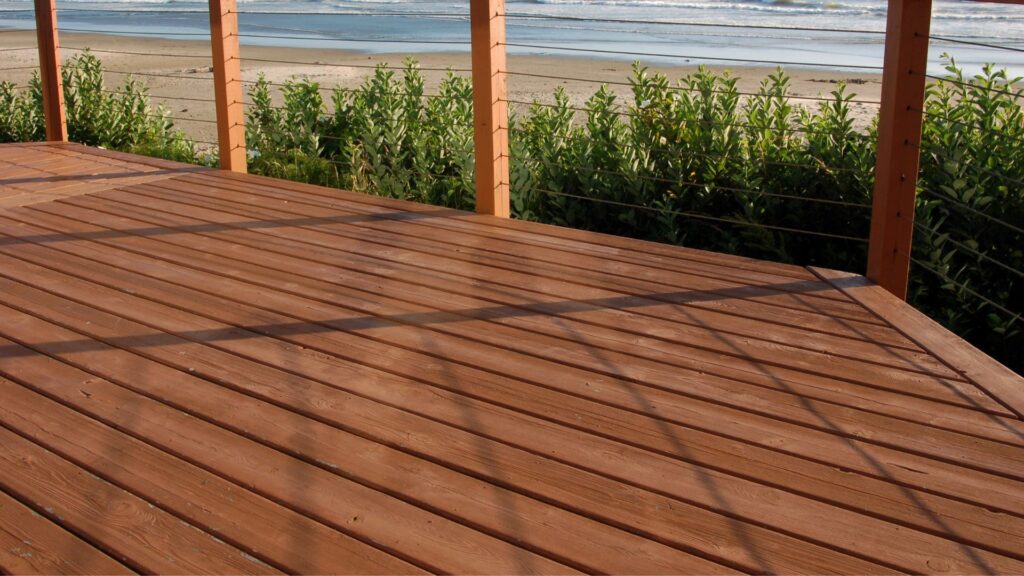
How To Budget And Save On Your Deck Project
Building a deck is a big investment, and while it can add value to your home and lifestyle, the costs can quickly add up if you don’t plan carefully. By being smart about budgeting and knowing where you can cut costs without cutting corners, you’ll be able to keep the overall cost of decking in NZ more manageable. Here are some practical ways to save money while still getting the deck you want.
Get Multiple Quotes
Never settle for the first price you’re given. Reach out to at least three different builders or contractors and ask for detailed quotes that break down material, labour, and additional costs. This way, you’ll not only see the price differences but also get a sense of each builder’s professionalism and expertise. Sometimes, the lowest quote isn’t the best option, but comparing multiple offers ensures you won’t overpay.
Choose Cost-Effective Materials Without Compromising Safety
The material you choose has the biggest impact on your budget. Pine is the most affordable decking material in New Zealand, but it requires regular maintenance. Composite, on the other hand, costs more upfront but saves money long term with minimal upkeep. To strike the right balance, consider your lifestyle, maintenance commitment, and budget. Always prioritize materials that meet safety standards, cutting corners here can lead to costly repairs or risks later.
Build In Stages If Needed
If your dream deck is bigger than your budget, consider building it in stages. Start with the main platform so you can use it right away, and then add features like stairs, railings, or built-in seating when funds allow. This phased approach helps spread the costs over time and makes the project more financially manageable without sacrificing your overall vision.
Seasonal Discounts Or Off-Peak Building Times
Timing your project can make a noticeable difference in cost. Many builders are busier during summer when demand peaks, which can drive up both labour costs and waiting times. If possible, schedule your deck build in the off-season, such as autumn or winter, when contractors may offer better rates or be more flexible with timelines. You might also find discounts on decking materials during seasonal sales at hardware stores.
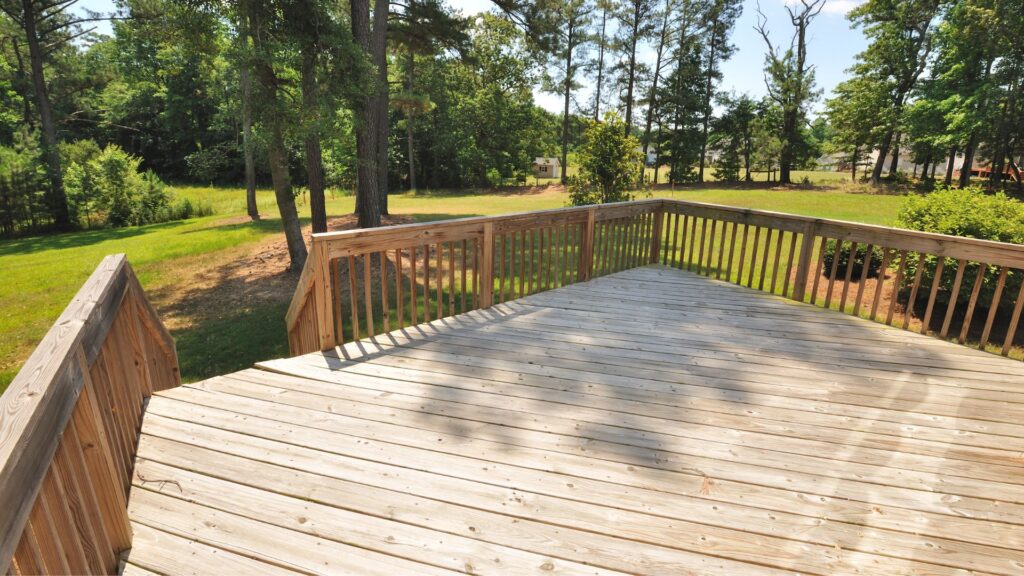
Common Mistakes That Increase Costs
Underestimating Site Prep
- Deck projects often run over budget before a single board goes down. The reason is site prep.
- Sloped or uneven ground needs levelling, extra posts, and deeper footings. That adds time and materials.
- Soft or reactive soil may need larger piles or ground screws. Builders will not skip this because safety depends on it.
- Poor access to tools and materials slows the job. Tight paths, steps, or narrow driveways mean more labour.
- Drainage matters. Water pooling under a deck leads to rot, mould, and movement. Add scoria, geotextile, or a simple French drain to keep the substructure dry.
- Trees and old concrete take time to remove. Plan for skip bins and disposal fees.
Action Steps
- Ask for a site inspection before quoting.
- Get a written scope that lists earthworks, footings, drainage, and access allowances.
- Add a 10–15% contingency to your budget for ground surprises.
Skipping Consents
- Building without consent can be costly. You risk stop-work orders, fines, and a rebuild to meet code.
- Deck height, proximity to boundaries, stairs, and balustrade details can trigger rules. Requirements vary by council across New Zealand.
- If you sell your home, missing paperwork can stall the sale or force retroactive fixes.
- Working with a Licensed Building Practitioner helps you meet standards and pass inspections.
Action Steps
- Call your local council early. Ask about height limits, barriers, and setbacks.
- Keep plans, specs, and product data sheets on file.
- Schedule inspections at the right stages so you do not have to undo finished work.
Poor Maintenance Leading To Higher Long-Term Spend
- Skipping basic care shortens deck life and increases total cost.
- Timber needs cleaning and regular oil or stain to block UV and moisture. When the finish fails, water enters the end grain and fasteners loosen.
- Hardware corrodes near the coast. Replace mild steel with stainless in salt air to avoid staining and structural issues.
- Algae and moss create slip hazards and trap moisture. A quick clean costs less than replacing boards.
- Composite needs less work, but it still needs washing to prevent mould on dirt buildup.
Simple Schedule
- Clean every change of season. Use a deck brush and mild cleaner.
- Re-oil softwood every 12–18 months. Oil hardwoods every 6–12 months based on exposure.
- Inspect fixings yearly. Tighten or replace where needed.
- Recoat high-traffic zones sooner than low-traffic areas.
Choosing The Wrong Material For Climate And Lifestyle
- The right board in the wrong place drives costs up through repairs and early replacement.
- Coastal homes face salt, wind, and intense sun. Choose hardwood or quality composite, stainless fasteners, and UV-stable finishes.
- Damp or shaded sites stay wet longer. Pick timber with high durability or composite with good slip resistance.
- High-sun decks can get hot underfoot. Lighter colours and ventilated subframes reduce heat build-up.
- Busy families and rentals benefit from low-maintenance options. A higher upfront price can beat years of sanding and staining.
- Love natural timber? Budget for regular care. Prefer low upkeep? Compare composite brands for warranty, cap stock, and fade resistance.
Action Steps
- Match material to exposure, foot traffic, and your appetite for maintenance.
- Handle sample boards in the sun and shade. Test under bare feet and when wet.
- Confirm warranty terms on colour fade, staining, and structural performance.
Quick Checks To Keep Costs In Line
- Get at least three like-for-like quotes with the same scope.
- Ask each builder to price site prep, drainage, footings, stairs, and railings separately.
- Confirm consent needs before you buy materials.
- Choose materials for your climate first, style second.
- Lock in a care plan from day one. A simple calendar beats costly repairs later.
Your perfect deck starts with the right plan. Check out our homepage now and take the first step toward a space you’ll love.
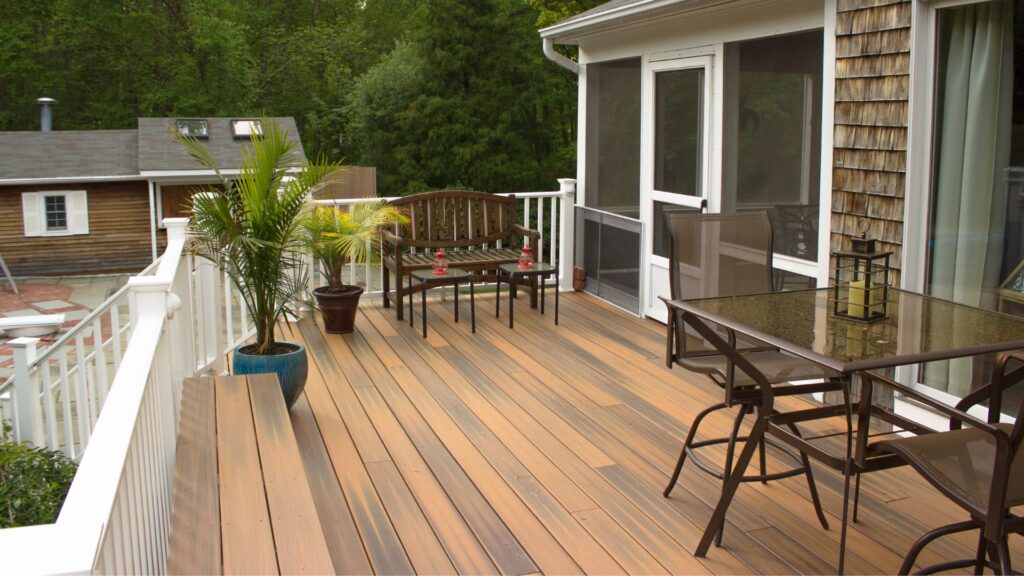
FAQs: About Cost Of Decking In NZ
What is the average cost of decking in NZ?
The average cost of decking in New Zealand typically ranges from $250 to $600+ per square metre. The final price depends on the materials used, the size and design of the deck, labour charges in your region, and any additional features like stairs or railings.
What type of decking material is the cheapest in NZ?
Pine is usually the most affordable decking material in NZ. It’s easy to source, widely available, and costs less upfront compared to hardwoods or composites. While pine decking requires more regular maintenance, it’s a budget-friendly option for many homeowners.
How much does composite decking cost in NZ?
Composite decking in NZ usually costs between $400 and $600 per square metre. Although it has a higher upfront price than timber, it requires very little maintenance, doesn’t need staining or oiling, and lasts longer, making it a popular long-term investment.
Do I need council consent for building a deck in NZ?
Yes, in many cases you will need consent. Decks that are higher than 1.5 metres above ground level generally require building consent from your local council. It’s important to check your regional council’s requirements before starting construction.
What hidden costs should I consider when budgeting for a deck?
Hidden costs may include site preparation (like clearing or levelling the ground), foundation work, retaining walls, fasteners, fixings, and council consent fees. You should also factor in ongoing maintenance costs such as staining, painting, or oiling timber decks.
Which decking material lasts the longest in NZ conditions?
Composite decking and hardwoods such as kwila generally last the longest. Composites can last 25 years or more with minimal upkeep, while hardwoods, if properly maintained, can also last several decades. Pine decking has a shorter lifespan if not maintained regularly.
Can I build a deck myself to save money?
Yes, DIY decking is an option and can save on labour costs. However, it requires good carpentry skills, the right tools, and an understanding of building codes. Mistakes can be costly, so many homeowners prefer hiring a professional for peace of mind and quality assurance.
How do labour costs for decking vary across New Zealand?
Labour costs are generally higher in major cities like Auckland and Wellington due to higher demand and living costs. In smaller towns or rural areas, you may find builders offering lower rates. Always request multiple quotes to compare prices in your region.
How much should I budget for deck maintenance each year?
For timber decks, you may spend around $100–$300 annually on oils, stains, or paints, depending on the size of the deck. Composite and PVC decks have minimal maintenance costs, which is why many homeowners choose them despite their higher initial cost.
Does adding a deck increase the value of a home in NZ?
Yes, adding a well-built deck can increase your home’s value. It improves outdoor living space, which is highly desirable for Kiwi buyers. The return on investment depends on quality, materials, and design, but a deck can be a strong selling point for your property.
Conclusion
When it comes to the cost of decking in NZ, there’s no single figure that applies to every project because the price depends on several key factors including the materials you choose, the overall size and complexity of the deck, labour costs in your area, and any extras such as railings, stairs, or built-in features. While it’s tempting to focus only on the upfront cost, thinking about long-term value is just as important, timber may be cheaper at first but requires ongoing maintenance, while composite costs more initially but offers years of low-maintenance use. The smartest approach is to compare multiple quotes, weigh up the pros and cons of different materials, and consider how your deck will fit into your lifestyle and budget over time. If you’re planning your deck, get clear quotes, ask the right questions, and choose an option that balances both affordability and durability so you can enjoy your outdoor space without unwelcome surprises down the track.

